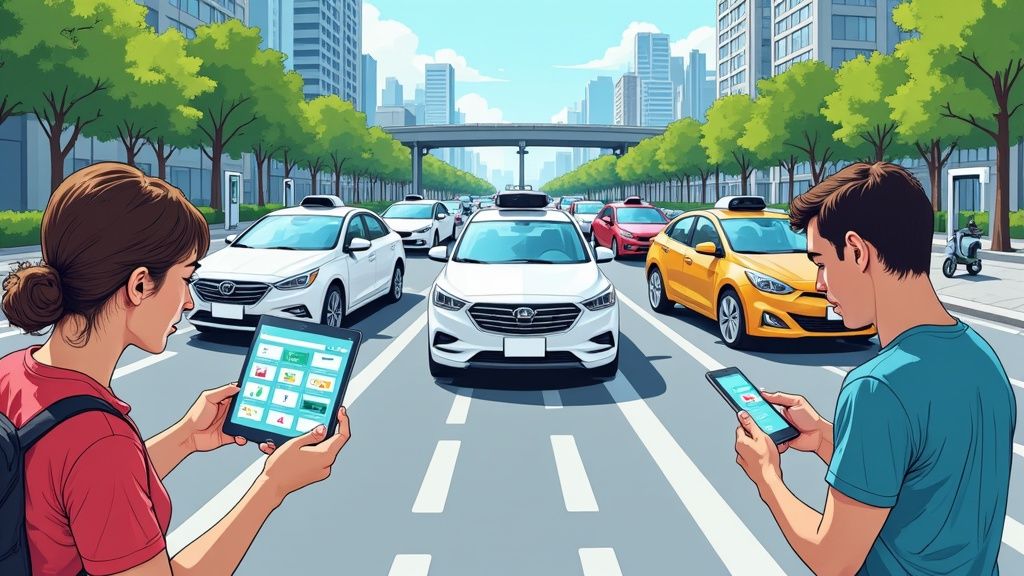
The Ultimate Guide to Finding Your Perfect App for Car Service: A User Success Story
Understanding the Evolving World of Car Service Apps
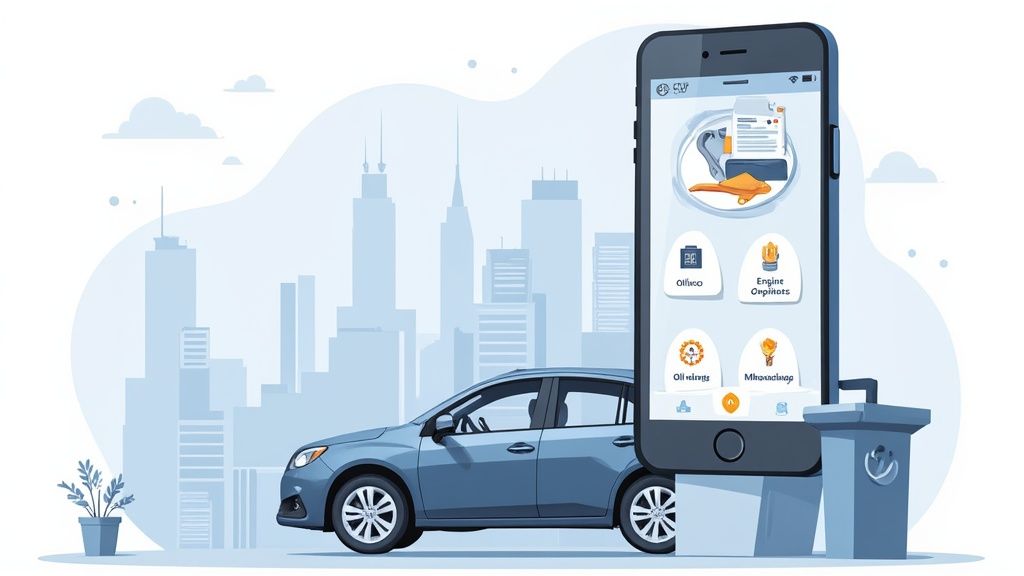
Getting a ride has changed dramatically in recent years. The familiar routine of waving down taxis or calling dispatch centers has given way to a simpler tap on our phones. This shift represents more than just an easier way to get around - it’s reshaping our relationship with transportation and city living. Understanding these apps has become key to making the most of modern mobility options.
The Growing Role of Car Service Apps
As cities expand and people seek more travel flexibility, car service apps have become increasingly vital. Recent market projections illustrate this trend clearly - the global ride-hailing sector is expected to reach USD 384.56 billion by 2031, growing at 13.3% annually from 2024. This expansion reflects how deeply these services have woven themselves into daily routines, from morning commutes to evening outings. Many apps now offer multiple options beyond cars, including bikes and scooters, making them indispensable tools for getting around efficiently.
Smart Ways People Use These Apps
Regular users have become quite skilled at getting the most from car service apps. Rather than simply booking the first available ride, they carefully select services based on specific needs. For instance, some opt for shared rides during rush hour to save money, while others prioritize premium options with enhanced safety features for nighttime travel. This thoughtful approach shows how people actively compare different apps’ features, prices, and reliability to find their best match. As a result, users are taking greater control over their travel experiences.
Learning From Real Customer Stories
The impact of choosing the right car service app becomes clear through actual user experiences. Take the case of business travelers who depend on specific apps because they consistently provide reliable airport pickups and simple expense tracking. Or consider parents who select certain services for their child car seat options. These examples highlight how the right app choice can reduce stress and improve convenience. On the flip hand, picking an unsuitable service might lead to delays, surprise costs, or safety worries. That’s why understanding your specific needs and researching different apps thoroughly makes such a difference in having positive travel experiences.
Decoding Must-Have Features That Actually Matter
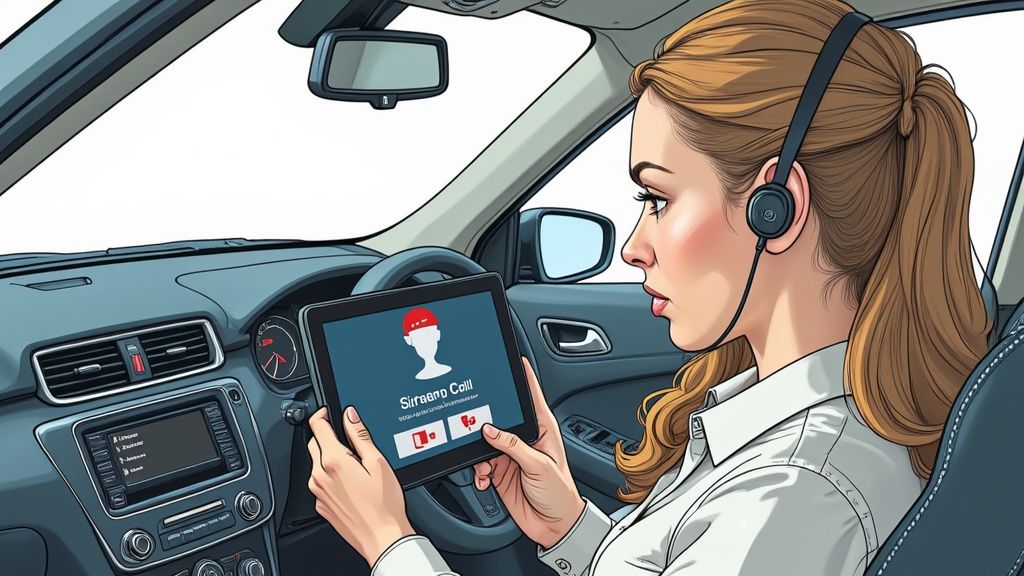
Finding the best car service app requires looking past fancy marketing to focus on practical features that make a real difference. Smart users know that certain key capabilities directly impact their experience and satisfaction. Here’s what truly matters when choosing a car service app.
Prioritizing Safety and Security
Safety features form the foundation of any reliable car service app. Real-time ride tracking lets passengers share their location with loved ones during trips. Emergency buttons provide quick access to help if needed. Clear driver profiles with background checks and reviews help users make informed choices about who they ride with. For example, someone taking a late-night ride can easily share their trip details with family for added peace of mind.
Seamless Payment and Fare Transparency
Clear, upfront pricing helps users avoid unwanted surprises and budget properly for trips. Multiple payment options like credit cards and digital wallets make transactions convenient. The ability to split fares with friends comes in handy for group rides. Detailed receipts break down costs and make expense tracking simple, which is especially useful when traveling for business or in unfamiliar cities.
Efficient Booking and Tracking Capabilities
Quick, simple booking is essential for a good car service experience. Saved locations and scheduled rides save time by eliminating repetitive address entry. Real-time vehicle tracking helps users plan better - they can see exactly when their ride will arrive and adjust accordingly. For instance, regular commuters can save their work and home addresses to book rides with just one tap.
Beyond the Basics: Personalized Features
While core functions are crucial, thoughtful extras can make apps more useful for different needs. Options for accessible vehicles, child car seats, and pet-friendly rides help serve diverse riders. Loyalty programs reward frequent users with perks like discounts and priority booking. These personalized touches help apps stand out and keep users coming back. Market research shows growing demand for such features - the global ride-hailing sector is expected to reach USD 384.56 billion by 2031 as consumers increasingly value convenience and customization in their transportation choices.
Making Sense of Top-Rated Service Platforms
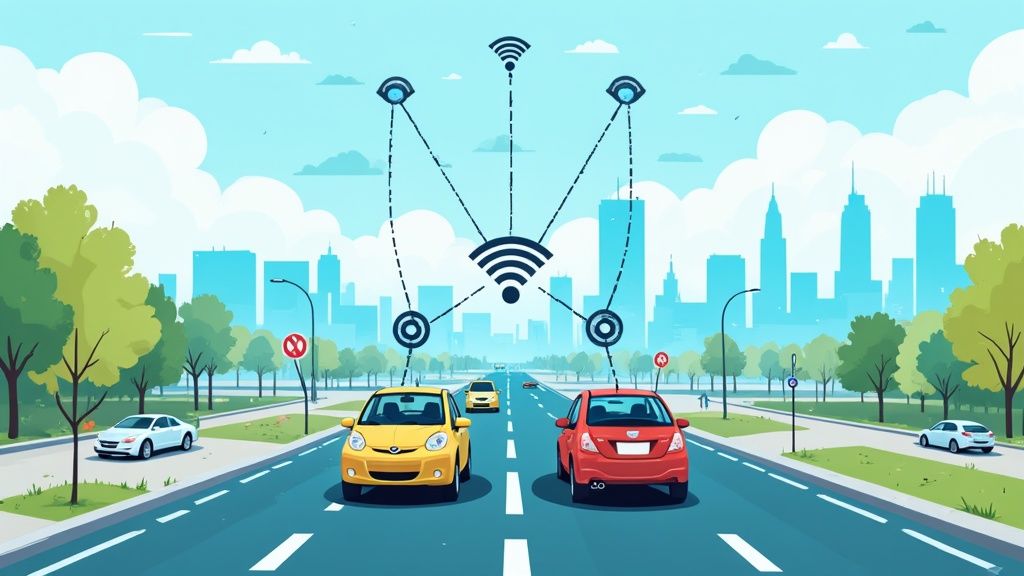
Finding the best car service app can be challenging given the many choices available today. To make an informed decision, you need to understand what sets different apps apart in terms of costs, service quality, and unique features. Let’s explore the main car service apps and analyze their key differences to help simplify your selection.
Key Players in the Car Service App Arena
Several established apps dominate the market, each with distinct advantages. Some prioritize budget-friendly rides, while others focus on premium experiences or specific offerings like carpooling. This variety lets you pick an app that matches your specific transportation needs, whether you value cost savings or premium service.
| Feature | App A | App B | App C |
|---|---|---|---|
| Pricing | Budget-friendly | Mid-range | Premium |
| Vehicle Types | Standard | Variety | Luxury |
| Service Area | Wide | Limited | Expanding |
| Special Features | Basic | Ride-sharing | Carpooling |
Evaluating User Satisfaction and Reliability
User reviews provide essential insights into how well these apps perform in real-world conditions. Important factors include typical wait times, driver professionalism, and customer service response. For instance, while an app may offer attractive rates, frequent service delays can quickly overshadow any cost benefits. The true test comes during challenging conditions like rush hour or bad weather.
Navigating Peak Hours and Special Requests
How apps manage high-demand periods reveals much about their service quality. While price increases during peak times are common, some apps handle this better than others. The ability to accommodate specific needs - like child seats or accessibility requirements - is also crucial. These factors often make the difference between a merely adequate service and one that truly serves its users well.
Real-World User Experiences: Successes and Shortcomings
Looking at actual customer experiences helps paint a clear picture of what to expect. Success stories often highlight quick pickups and smooth rides, while complaints typically focus on billing issues or cancellation problems. For example, one user might praise an app’s consistent service, while another points out problems with refund policies. These real experiences help reveal the practical strengths and limitations of each platform.
The car service app industry continues to grow, with projections showing the global ride-hailing market reaching USD 384.56 billion by 2031. This expansion shows how central these apps have become to modern transportation. When choosing an app, consider your priorities around cost, reliability, and specific features you need. Understanding these aspects helps ensure you select a service that best fits your transportation needs.
Unlocking Hidden Value in Your Chosen App
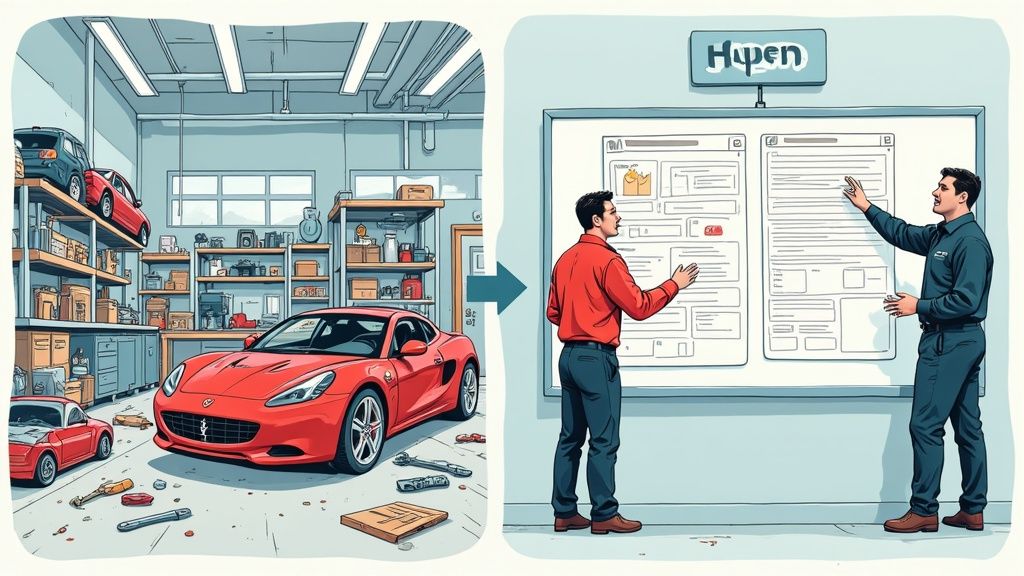
Selecting an app for car service is just the beginning. To get the most value, you need to understand its key features and use them effectively. It’s similar to getting a new computer - you only tap into its real potential once you learn how all the tools and functions work together.
Mastering the Art of Timing and Features
Price fluctuations are common in ride-hailing apps, with fares changing based on demand patterns. Smart users avoid peak pricing by booking rides just before or after rush hour, or by choosing shared rides when possible. Some apps also offer special discounts for advance bookings or when using specific payment methods. While these savings may seem small individually, they build up significantly with regular use. A few strategic adjustments to your booking habits can lead to meaningful cost reductions over time.
Proactively Managing Service Issues
Sometimes rides don’t go as planned - drivers run late, routes get mixed up, or billing questions arise. Knowing how to handle these situations through the app’s support channels makes a big difference. Most apps provide instant help through their platform, but it’s wise to also know alternative ways to reach support, like phone numbers or email addresses. For regular riders, being familiar with these communication options ensures any problems get resolved quickly and smoothly.
Becoming a Power User: Tips and Tricks
The most experienced users combine multiple app features to create a seamless experience. They use scheduled rides with real-time tracking to ensure punctual arrivals for important meetings or flights. They also make the most of loyalty programs and referral bonuses to reduce costs. This approach turns a basic ride-booking tool into a personal transportation assistant. Like keyboard shortcuts on a computer, these individual features may seem minor, but using them together makes a big impact on both convenience and cost savings. With ride-hailing expected to grow to $384.56 billion by 2031, mastering these strategies will help you make the most of these essential transportation services.
Understanding Regional Service Differences
When picking a car service app, location matters more than you might expect. The app that serves you perfectly in one city could be completely different - or even unavailable - in another. This reality means users need to understand how geography impacts their transportation options.
Availability and Market Penetration
Car service apps have vastly different coverage areas and service levels across regions. While major international players operate in many countries, other services focus on specific cities or regions. Local regulations and licensing rules also determine which apps can operate where. Before relying on your usual app in a new location, it’s essential to check if it’s available and fully functional there.
Pricing Structures and Local Competition
Costs for the same service can differ significantly between locations. Prices typically reflect the local market - things like fuel costs, driver wages, and how many competing services operate in the area. For example, an app might offer great rates in a city with many options but charge more in places with less competition. That’s why comparing prices between available apps in each specific location helps find the best deal.
Cultural Factors and User Preferences
Local culture shapes how people use car services. Features that matter a lot in one place, like in-app tipping or language options, may be less important elsewhere. Vehicle preferences and service expectations also vary based on local norms - what’s considered basic service in one region might be premium in another. For instance, in areas where shared rides are common and accepted, apps with strong carpooling features often do better than those focused on private rides.
Adapting Your Strategy for Seamless Travel
Understanding these regional differences helps you plan better transportation. Research available apps at your destination before traveling and compare their features, prices and reviews. Having multiple car service apps installed gives you more flexibility to compare real-time rates and availability - similar to how travelers check different airlines for the best flight deals. This preparation helps avoid surprises and ensures you can get around efficiently wherever you go.
Preparing for Tomorrow’s Transportation
The transportation landscape has evolved from street-corner hails to phone dispatches and now digital ride-hailing apps. As these changes accelerate, it’s crucial to not just understand current trends but also anticipate future developments. Let’s explore the emerging technologies shaping car services and how to adapt to these changes.
The Rise of AI and Predictive Analytics
Artificial Intelligence is already making car service apps smarter and more efficient. For instance, AI now optimizes routes by analyzing traffic patterns and predicting congestion spots, which reduces both travel time and fuel usage while supporting greener transportation. The technology also creates more personalized experiences by learning user preferences like frequent destinations and preferred vehicles. This allows apps to provide relevant recommendations and simplified booking processes, paving the way for even more intuitive experiences.
Sustainable Transportation: The Electric and Autonomous Future
Environmental awareness is driving changes in transportation services. Many ride-hailing apps now offer electric vehicle options to meet growing demand for eco-friendly rides, supporting broader goals of reducing emissions. But sustainability extends beyond electric cars - autonomous vehicles (AVs) represent the next frontier. Companies like Waymo already operate self-driving ride services in some cities, signaling a future where human drivers may become optional. This shift prompts important discussions about safety standards, regulations and what defines a “car service.”
Getting Ready for the Driverless Era
The move toward autonomous vehicles raises key questions for consumers about integration, accessibility, and safety measures. How will self-driving cars work with existing transportation networks? Will they be affordable for average users? What safety protocols will protect passengers? Understanding these aspects of AV technology will help users make informed choices as autonomous options become more common. Staying current on developments and participating in public discourse around implementation will be valuable as this technology matures.
The Connected Car and Beyond
Integration between apps and connected vehicle systems offers exciting possibilities. Imagine ride-hailing apps that automatically set your preferred temperature and music before you enter the car. This seamless experience could extend further as car service apps evolve into complete mobility platforms that combine ride-hailing, public transit, and micro-mobility options like scooters. Such integrated systems would give users efficient ways to navigate cities regardless of distance or destination.
Ready to take control of your vehicle maintenance records and prepare for the future of car ownership? Auto Service Logger provides a secure and efficient way to track all your vehicle maintenance, ensuring you’re prepared for whatever the road ahead may bring. Start your lifetime membership today! https://autoservicelogger.com/